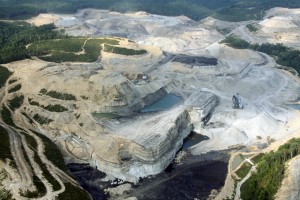What is mountaintop removal coal mining?
 Mountaintop removal coal mining is a method of coal mining that uses dynamite to blast off tops of mountains to access underlying low sulfur coal seams in the Appalachian mountains of the U.S. (Hartman et al., 2005, Merovich et al., 2007). Overburden (spoil) rock is placed in adjacent valleys, forming what is known as a ‘valley fill’, which can significantly alter local stream hydrology as stream headwaters are permanently buried. As rock and coal are exposed, contaminants may be released into surrounding stream ecosystems during coal mining operations. One of the major contaminants of concern from mountaintop coal mining/valley fill operations is selenium. Selenium, a trace element, is necessary at very low levels for animal survival but at higher concentrations can be toxic, especially to oviparous vertebrates like birds and fish (Holm et al., 2005, Lemly 2002). Another major concern is that mountaintop removal coal mining causes significant increases in stream water conductivity (Lindberg et al., 2011). Increased stream conductivity can highly impact native stream communities, especially invertebrates (Pond et al., 2008).
Mountaintop removal coal mining is a method of coal mining that uses dynamite to blast off tops of mountains to access underlying low sulfur coal seams in the Appalachian mountains of the U.S. (Hartman et al., 2005, Merovich et al., 2007). Overburden (spoil) rock is placed in adjacent valleys, forming what is known as a ‘valley fill’, which can significantly alter local stream hydrology as stream headwaters are permanently buried. As rock and coal are exposed, contaminants may be released into surrounding stream ecosystems during coal mining operations. One of the major contaminants of concern from mountaintop coal mining/valley fill operations is selenium. Selenium, a trace element, is necessary at very low levels for animal survival but at higher concentrations can be toxic, especially to oviparous vertebrates like birds and fish (Holm et al., 2005, Lemly 2002). Another major concern is that mountaintop removal coal mining causes significant increases in stream water conductivity (Lindberg et al., 2011). Increased stream conductivity can highly impact native stream communities, especially invertebrates (Pond et al., 2008).
Current research
 The West Virginia mountaintop removal coal mining project is a collaboration between many laboratories at Duke University and elsewhere. Our research is done primarily on the Mud River in Boone county of West Virginia. We are also adding sites in the Big Ugly Wildlife Management Area this year. The Di Giulio laboratory aims to identify ecosystem and organism effects of mountaintop removal coal mining as well as to identify mechanisms of toxicity for selenium exposure in embryonic and larval fish. Recently Ty Lindberg, Dr. Di Giulio, and collaborators published a paper in PNAS describing their work on cumulative impacts of mountaintop removal coal mining on water quality in the Mud River. Click here for more news on our mountaintop mining research.
The West Virginia mountaintop removal coal mining project is a collaboration between many laboratories at Duke University and elsewhere. Our research is done primarily on the Mud River in Boone county of West Virginia. We are also adding sites in the Big Ugly Wildlife Management Area this year. The Di Giulio laboratory aims to identify ecosystem and organism effects of mountaintop removal coal mining as well as to identify mechanisms of toxicity for selenium exposure in embryonic and larval fish. Recently Ty Lindberg, Dr. Di Giulio, and collaborators published a paper in PNAS describing their work on cumulative impacts of mountaintop removal coal mining on water quality in the Mud River. Click here for more news on our mountaintop mining research.
Gallery of pictures
Research collaborators:
